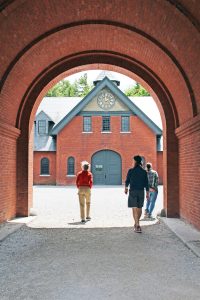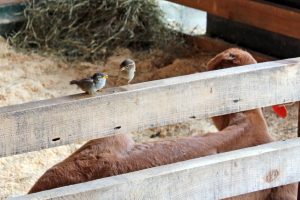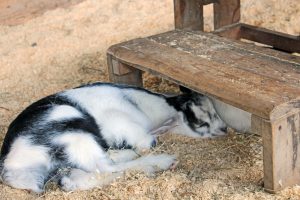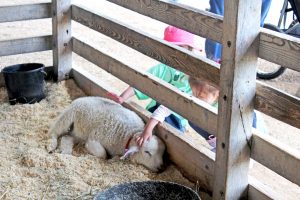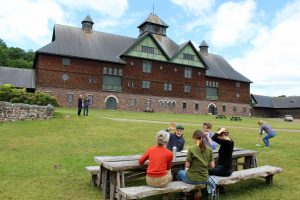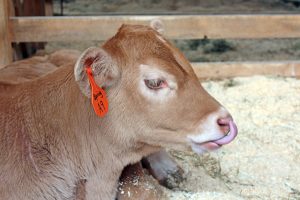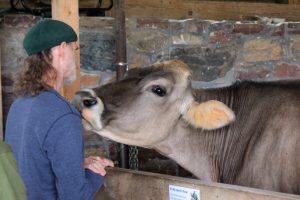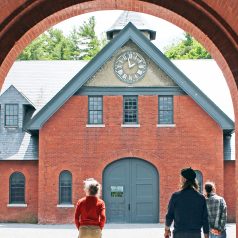
Field Trip to Shelburne Farms
As staff members at the Co-op, we take pride in being well-versed about the products that we offer and strive to take an active role in our local food system. To achieve this end, we sometimes venture out beyond the walls of the store to visit the local farms that sustain us. These visits allow us to form personal connections with farmers and producers, and learn parts of their unique story that can’t necessarily be shared on a product label. It also lends a first-hand account of the efforts that go into producing local foods, which creates a new level of appreciation for the fruits of that labor when those products arrive on our store shelves.
With this in mind, 5 Co-op staffers enjoyed a recent adventure to Shelburne Farms. We all adore their award-winning cheddar, but we also know that Shelburne Farms is about so much more than great cheese. Incorporated as a nonprofit in 1972, Shelburne Farms has come a long way in transforming itself from a private estate threatened by development and decay into a thriving education center that weaves together agricultural stewardship and enterprise with land conservation. In addition to farmhouse cheesemaking, there are grass-based dairy, beef, and sheep operations; maple sugaring; vegetable gardens; and small-scale poultry, honey, and mushroom production. At the heart of each of these operations is a unifying educational thread aimed at increasing awareness about the interconnected nature of food and community and how our choices affect the health of ourselves, others, and the natural world. More than 150,000 people visit the Farm each year and benefit from the diverse array of educational programming geared toward educators and students of all ages.
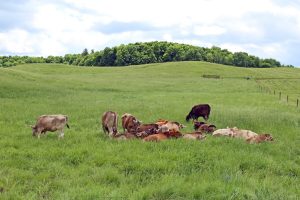
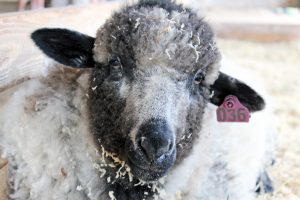
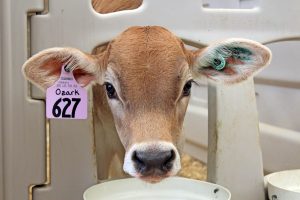
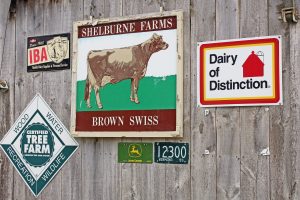
As we entered the Shelburne Farms campus, we marveled at the beauty of this 1,400-acre working farm, forest, and National Historic Landmark. We wandered into the courtyard of the Farm Barn, weaving our way thorough free-ranging hens and excited school children, and followed our noses straight to the Farm Cart which was serving up fresh, healthy meals featuring local ingredients. We savored our lunch at a nearby picnic table and were joined by a special guest – a very curious hen!

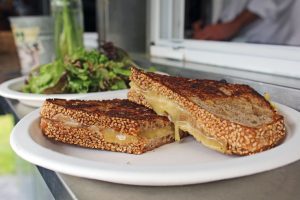
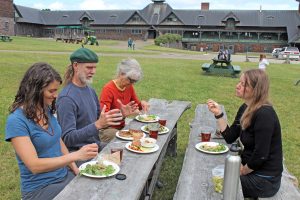
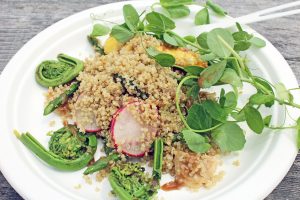
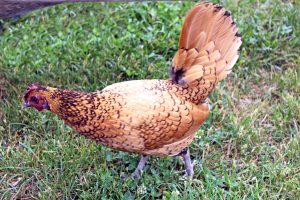
After enjoying a delicious lunch, we met our host for the day, Rory Stamp. Rory joined the Farm in 2015 as the Cheese Sales Manager. He coordinates with the cheesemaking team and mail order staff to deliver their cheddar everywhere from the Welcome Center to Southern California, finding a home for each and every morsel of their 170,000 pounds of annual raw milk cheese. For the better part of a decade, he has worked in the New England artisan cheese scene, doing everything from distributing raw milk in Connecticut and milking cows at an organic dairy on Martha’s Vineyard, to making award-winning cheese in Vermont and buying wine for a cheese shop and importer in Cambridge, MA. Rory is an experienced food educator, and admits that he loves nerding out on cheese and all things fermented. His knowledge and passion for the craft of artisan cheesemaking was apparent as he described the Sun To Cheese process at Shelburne Farms.
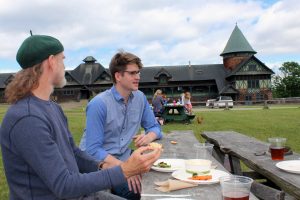
Sun to Cheese? Yes; that’s how Rory describes it, because the delicious taste of the cheese starts way before the milk hits the cheesemaking vat. It begins with the sun shining on the lush pastures at the Farm. The herd of Swiss Brown cows that graze on the grasses and flowering plants in their pastures walk about 1.5 miles a day. The cows are milked each morning and evening, and all of that raw milk goes directly to the cheesemakers by mid-morning. They don’t hold or store any milk, so the milk going into each batch of cheese is as fresh as possible, but this also means that they must make cheese every single day!
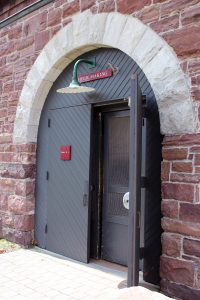
Rory led us into the cheesemaking facility, where we had the pleasure of watching the process in action. A chalk board indicates the names of the cheesemakers for the day, the time at which they received the milk, the volume of milk received, and the precise timing for each of the critical steps though the process of turning that milk into cheese. It was so interesting to see the cheesemakers at work and to appreciate the very physical nature of the process. Rory walked us through the steps of first adding starter culture and rennet to the milk, which magically transforms the milk into curds and whey. The curds are cooked and stirred into the whey, then the whey is drained into an underground tank, later destined to be returned to the very fields where the Sun to Cheese process began! The whey helps return valuable minerals to the soil, preserving it’s richness and lending nutrient-density to the grasses that will again grow and nourish the cows. It’s all part of a beautiful, cyclical process that honors the land, the animals, and the cheese.
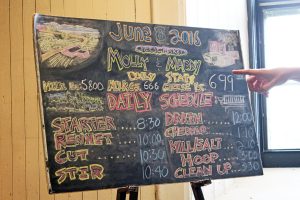
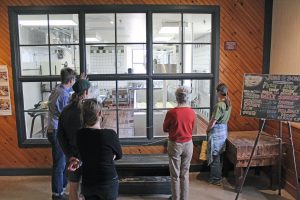
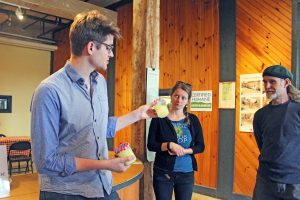
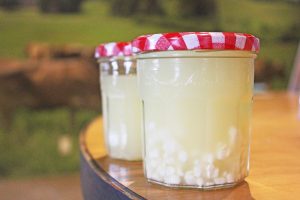
Back in the cheesemaking room, the next step is to form the remaining curds into semi-firm “packs”. Packs are cut into slabs that are then stacked and turned in a very rhythmic process known as “cheddaring”. Next comes milling of the slabs into “fingers”, which maximizes surface area for salting. The salt is added, which curtails the starter culture development and adds flavor. Finally, the fingers are put into compressible forms known as “hoops”, which are pressed overnight to remove the very last of the whey, producing solid, 40-pound blocks of cheese ready for aging.
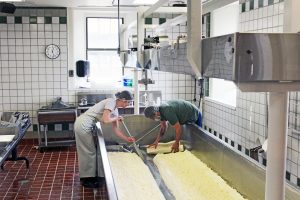
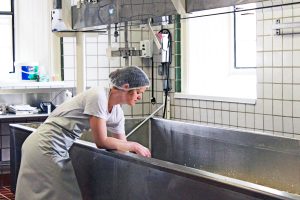
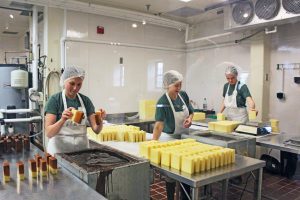
Rory explained that each batch of cheese is unique. While there are many parts of the process that are precise and well-controlled, there are also many dynamic components that allow for subtle variation. There are inherent seasonal changes to the cows’ diet, which is predominantly fresh grasses during the spring and summer, and dried grasses in the winter, supplemented with small amounts of non-gmo, organic grain. This, combined with seasonal changes in their level of physical activity, brings varying levels of butterfat content and subtle changes in the flavor of the milk. He also pointed out that even the mood and energy of the cheesemakers on a particular day seems to have an influence! The cheesemakers keep a detailed written record of each batch with technical details about the nature of the milk and curd, but also with notes about how they were feeling that day. Some of their top award-winning batches came from days when the cheesemakers were feeling particularly upbeat.
Customers want a certain level of consistency in a cheese they’ve come to know and love, so Rory explained that each batch of cheese is sampled throughout the aging process in a sort of vetting process which determines the final product of that particular batch of cheese. Some cheeses are released at the 6-month mark, to be sold as a soft, creamy, buttery cheese that is perfect for melting on a grilled cheese sandwich. Other batches continue to age to the 1-year mark, where it becomes slightly sharper and crumblier. The batches that seem to be aging with the best consistency to their ideal standards remain in the aging cellar to become their signature 2-year Extra Sharp Cheddar, with its delicious crystalline flecks and crumbly texture. Of course, there are occasionally batches that seem to have a mind of their own as they age and stray a bit too far beyond the norm. These cheeses are sold on the farm as “Tractor Cheese”.
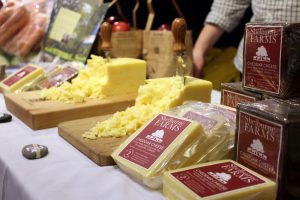
While most of the cheeses of Shelburne Farms are produced and aged on site, there are two varieties that take a field trip of their own: A small and special portion of the cheese is selected to be wrapped in cloth and sent to the Cellars at Jasper Hill in Greensboro, VT, where it is aged to perfection in a traditional English process – binding curds in cheesecloth, sealing with lard, and cave-aging over a year – yielding a cheese with a flaky texture, woodsy flavor, and long, brothy finish known as Shelburne Farms Clothbound Cheddar. The other traveling cheese is their famous smoked cheddar, which leaves the Farm after 9 months of aging and travels to a monastery. Brother Luke and the Monks of New Skete in nearby Cambridge, New York use a cold smoke process to hickory smoke this young cheddar for six hours, giving it a subtly sweet, bacon-like flavor.
We enjoyed sampling each of these varieties of cheddar and marveled at how unique they were at each stage of the aging process, despite all having such a similar origin. It’s fun to enjoy the cheeses in a “flight” beginning with the young, mild, smooth 6-month cheddar and working through the sharp, complex, crumbly, aged varieties, then finishing with the robust smoked cheddar. What a journey for the taste buds!
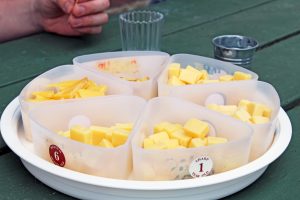
We had such a wonderful time at Shelburne Farms and are so grateful to Rory for being such an excellent host! We departed with full, happy bellies, a head full of newfound knowledge about how their cheese finds it way to our shelves, and heart full of appreciation for the incredible work they do at the Farm in their quest to educate for a sustainable future!
